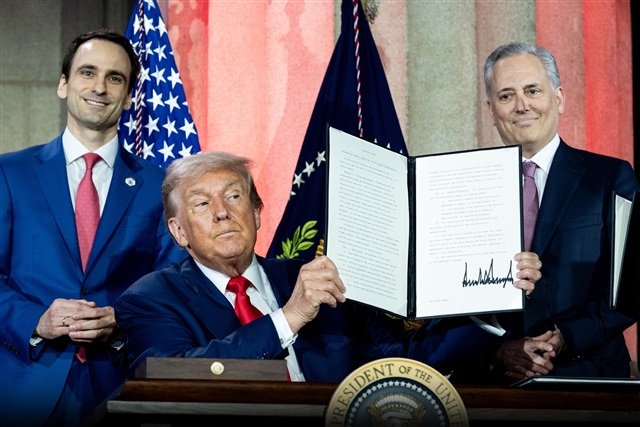In a bold move to regain technological leadership, former U.S. President Donald Trump announced that the United States will loosen regulations surrounding artificial intelligence (AI). This significant shift in Trump AI policy is part of a larger plan to ensure that the U.S. not only competes in the global AI race—but wins it.
As AI continues to transform everything from healthcare and education to military operations and job markets, Trump’s statement has sparked national and international reactions. While some see it as a necessary step toward innovation and dominance, others warn of the dangers of deregulation.
In this article, we’ll dive deep into what Trump’s AI policy means, what rules might change, how this impacts the AI race with countries like China, and what it could mean for the future of technology and safety in America.
Why Trump Wants to Loosen AI Rules
Trump AI policy has always been about “America First”—and in the case of artificial intelligence, that slogan is getting a tech-era reboot.
During a recent rally and in follow-up interviews, Trump claimed that too many regulations are slowing down American tech companies, forcing them to compete unfairly with foreign rivals, especially in China and Russia. He argued that unless the U.S. acts fast, it risks falling behind.
“We’re getting crushed by red tape,” Trump said. “Other countries don’t wait. They build fast, they test fast, and they win fast. We need to cut through the rules and put America back on top.”
This announcement marks a dramatic change from current federal approaches that focus on AI safety, ethics, and bias prevention.
What Rules Could Be Loosened?
While Trump has not yet revealed an official policy paper, insiders and tech analysts expect several key areas to be targeted:
1. Fewer Restrictions on AI Data Use
Currently, American tech companies must comply with various data privacy laws, such as the California Consumer Privacy Act (CCPA). Trump’s proposed changes may involve less strict rules on how companies gather and use data to train AI systems.
2. Faster AI Model Approvals
Under current rules, AI systems—especially in healthcare, autonomous vehicles, or defense—often go through slow and complex approval processes. Trump wants to fast-track these approvals.
3. Looser Rules for Military AI
Trump may push for more flexible policies in developing AI-powered military tools, including surveillance drones, cyber tools, and autonomous weapons.
4. Limiting the Role of AI Ethics Boards
Recent administrations emphasized the need for ethical AI, with many companies required to follow “AI ethics guidelines.” Trump’s stance may reduce the influence of these boards, allowing companies to innovate faster, without being slowed by ethical constraints.
Trump AI Policy vs. Biden’s Approach
The Trump AI policy is a stark contrast to President Biden’s recent executive orders, which focus heavily on AI safety, transparency, and job displacement. Biden’s plan calls for more oversight on how AI is used, particularly in high-risk sectors.
Trump’s new AI stance turns that around. His policy emphasizes speed, flexibility, and freedom for innovation—arguing that excessive regulation will only make the U.S. fall behind.
Here’s a quick comparison:
| Policy Area | Biden’s Approach | Trump’s AI Policy |
|---|---|---|
| AI Safety | Strict monitoring & ethics | Deregulation |
| Data Privacy | Strong protections | Fewer restrictions |
| Military AI | Cautious development | Full-speed ahead |
| AI in Business | Risk assessments | Fast deployment |
| International Cooperation | Focus on alliances | America First |
The Global AI Race: Why Speed Matters
Countries like China, the UK, and the UAE are investing billions into AI research and infrastructure. China, in particular, has announced plans to become the world leader in AI by 2030.
Trump argues that if America plays “too safe,” it will lose this technological war.
AI is already being used in:
- Facial recognition systems
- Predictive policing
- Autonomous weapons
- Financial trading
- Healthcare diagnostics
Whoever controls the most advanced AI systems will have a major edge in both economic and military power.
“It’s a new arms race,” says Dr. Kelly Nguyen, a tech policy analyst. “And in Trump’s eyes, AI is the new nuclear weapon.”
The Upside: What Loosening AI Rules Could Achieve

Supporters of Trump’s AI stance argue that loosening rules can:
- Unleash American innovation
Tech companies can launch products faster, without months of red tape. - Boost the economy
AI jobs are expected to grow by over 30% in the next five years. Lighter regulations could accelerate that growth. - Strengthen military dominance
Faster development of AI in defense could secure America’s leadership in global security. - Compete with China
The U.S. can match or exceed China’s aggressive AI advancements.
Tech CEOs and venture capitalists have largely welcomed the shift, with some calling it “exactly what’s needed to keep America competitive.”
The Risks: What Could Go Wrong?
Not everyone is celebrating the Trump AI policy.
Critics warn that removing safety checks could lead to serious dangers, including:
1. Unethical AI Use
Without ethical boards or review, companies may launch AI tools that are biased, discriminatory, or harmful.
2. Job Displacement
AI is already replacing jobs in customer service, data entry, and even journalism. Looser rules may speed up job loss across sectors.
3. Surveillance & Privacy Violations
Fewer data regulations could lead to mass surveillance, facial recognition abuses, and the misuse of personal data.
4. Autonomous Weapons
Perhaps the most alarming concern is the unchecked development of AI in weapons, which could trigger a global arms race or accidents in warfare.
Dr. Samantha Clark, an AI ethicist, warns:
“AI is not just software. It’s power. And without rules, power can become dangerous—especially in the wrong hands.”
What Experts and Lawmakers Are Saying
Supporters:
- Elon Musk (X/SpaceX/Tesla CEO): “AI must be safe, but speed matters. Trump’s view will boost US innovation.”
- Peter Thiel (Investor): “Government should stop slowing down American genius.”
- Vivek Ramaswamy (Entrepreneur & politician): “AI regulation should empower, not strangle, U.S. potential.”
Critics:
- Senator Elizabeth Warren: “Trump’s AI policy will open the floodgates for abuse. We need smart regulation.”
- AI Now Institute: “This is not a race worth winning if we lose safety, privacy, and ethics in the process.”
What Happens Next?
Trump has vowed that, if re-elected in 2025, AI deregulation will be one of his first executive orders. Until then, the debate is expected to continue through the 2024 election season and beyond.
In the coming months, expect:
- More political divisions on AI policy
- Public hearings and debates in Congress
- Increased lobbying by tech companies
- Global reactions from AI competitors like China and the EU
Final Thoughts: Can the U.S. Win the AI Race?
The Trump AI policy signals a clear shift toward speed and dominance, even at the risk of oversight and ethics. Whether that approach will help the U.S. win the AI race—or lead to unforeseen dangers—is still up for debate.
What’s clear is this: AI will define the future of power, and how the U.S. chooses to govern it today will shape our world tomorrow.
The stakes are high. The clock is ticking. And the AI race is far from over.
Read Next – U.S. Companies Confront Stricter SEC Climate Disclosure Rules






